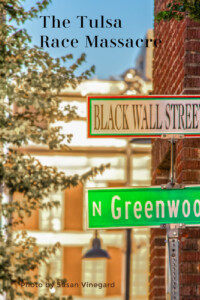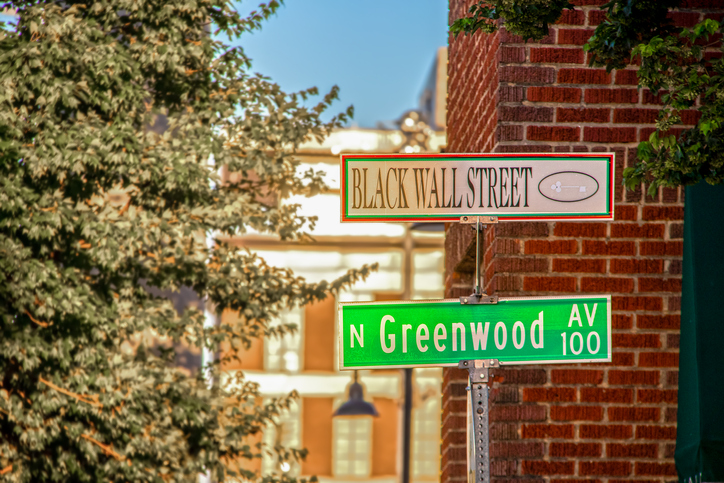The Tulsa Race Massacre

The Tulsa massacre.
It has been ninety-nine years since the Tulsa massacre. Will Tulsa do something about its centennial in 2021?
There are no words to describe the 1921 Tulsa Race Massacre. You know what started this one? Jealousy.
White people didn’t think black folks deserved to be as wealthy – and certainly not wealthier – than they were, so they took matters into their own hands. The rest is partly-hidden-history. At least, that’s one side of the story. The folks responsible for what happened aren’t here to tell the story, but the children and descendants of the victims and instigators are.
Tulsa was divided by race, and its geographic divide ran mainly along the Frisco railroad tracks. In addition to skin color, Tulsans were also separated economically and politically.
The African American section on the northeast side of town was relatively prosperous. Some of its residents had worked hard and lived thriftily, achieving a remarkable high standard of living, for which some white folks were upset. The real name for that is jealousy. You know what we do when we become jealous? We look for a way to knock ’em down and to show them we’re bigger or better, or smarter or richer.
The cause
What incited the riots, anyhow? Was it the elderly black couple who refused to give up their street car seats to a white person? Or was it the young black man (Dick Rowland) who stepped onto an elevator with a white operator who screamed because he supposedly stepped on her foot?
Whatever it was, the Tulsa Tribune published an article with the headline “Nab Negro for Attacking Girl in Elevator” and ran an ominous editorial: “To Lynch Negro Tonight.” Rowland was accused of assault and rape (and later acquitted).
A white mob gathered outside the courthouse and and black men stood outside wanting to protect Rowland. A shot was fired, then more shots.
The massacre
It was May 31, 1921. The massacre had begun. Hundreds of white people marched on Black Wall Street, bombs were dropped from airplanes, and hundreds were injured. More than 35 blocks of Greenwood were destroyed. More than 1000 homes and businesses were destroyed. It was the deadliest race riot in US History, and destroyed Greenwood in less than forty-eight hours.
The National Guard was sent in and by the time Governor J. B. A. Robertson declared martial law shortly before noon, the massacre had ended. The death count was listed as 300.
Public funerals for the black dead were banned to avoid any potentially explosive gatherings, and insurance companies refused to compensate the victims.1
Memories from survivors of the Tulsa massacre
In 1999, Clyde Eddy, a white man who was ten at the time, told officials he spotted white men digging a trench. When the men left, Eddy peeked inside the crates and saw black corpses.
George Monroe, a five-year old at the time, remembers: “all of a sudden my mother was excited. She saw four men coming toward our house, and all of them had torches, lighted torches and they set fire to the curtains, and as a result everything in and around our house was burning.”
The day of the riot Eldoris McCondhi was nine years old. She remembers her fear. “I was real frightened when my mother said we had to get out. She said ‘white people are killing colored people.’ We went out and there were lines of people heading north on the railroad track, on the sides and on the middle; we didn’t have time to get dressed. Bullets were just raining down over us; I could see the airplanes and I was so frightened. There was a white farmer who came out and told us that as many as could get in his house could stay there. ” Thank God for that white farmer.
Rebuilding
By the 1940s, the Greenwood District was rebuilt; but due to integration during the Civil Rights era, it never regained as much prominence as it had before the massacre.
White people had destroyed black business establishments and homes, and white superiority was maintained. It makes me angry.
Two days after the riot, the mayor established the Reconstruction Committee to redesign the Greenwood District for industrial purposes.2 Blacks were offered below market value for their property. This was just another way to crush people of color by white folks who thought they were better than them. Shame, shame.
Black Wall Street, as it was, no longer existed. Nevertheless, the people rallied and rebuilt their lives. Some moved away, but many stayed. This was home.
How does one rebuild a life after the horror they experienced? How did they continue day after day, knowing how unjust the massacre was? Why was it that no one was charged with the killings and burnings? How does one go on?
How does a community go on when it is haunted by its history? When the scope of the rampage is not resolved and the description of the violence [riot vs. massacre] is a point of contention, how does one find healing? How does a community rebuild?
What I know
One thing is for certain: we cannot find healing unless we admit the wrong and the pain. Ignoring what happened keeps the skeleton dangling in the closet, waiting for another outburst.
For years, this massacre was not taught in our schools. It was not until 2009 that this incident was included in Oklahoma history books.3 When we don’t want to tell the story, something is wrong.
This I also know: anger and bitterness paralyzes and enslaves us.
What has happened in the past cannot be undone. It can, however, be acknowledged. We cannot change the past, but we can direct the course of the future by our responses. We can reckon with the wrong and make things right by taking a different path.
Each of us will one day pay for our deeds. God said it, and it’s true. Payday will come, some day.
This I also know for certain: we need to come together at the Cross of Jesus Christ, where the ground is level and there is no distinction of color or creed. There, where the ground is level, there is enough blood for all, Every one of us needs to find forgiveness, and the only place to do it is at the Cross, where the ground is level and welcome to all.

Photo credits: iStockphotos
Footnotes:
1 https://www.theguardian.com/world/2000/jun/02/duncancampbell
2 https://daily.jstor/org.the-devastation-of-black-wall-street/
3 https://www.history.com/topics/roaring-twenties/tulsa-race-massacre
Sources:
jstorhttps://daily.jstor/org.the-devastations-of-black-wall-street
https://www.theguardian.com/world/2000/jun/02/duncancampbell
https://tulsaworld.com/tulsa-race-massacre
https://tulsaworld.com/news/local/racemassacre/timeline-the-1921-tulsa-race-massacre/collection_1c02a7b4-86ce-11e8-b63d-c3bbb45d4a6c.html#1
https://tulsaworld.com/news/local/racemassacre/timeline
https://www.washingtonpost.com/news/local/wp/2018/09/28/feature/they-was-killing-black-people
Tulsa Race Massacre – then and now.
Tulsa Race Riot Massacre Survivor– George Monroe
Black Wall Street Survivor Eldoris Mae McCondichi






